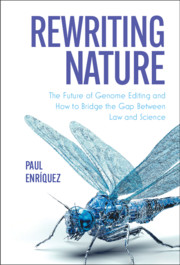Book contents
- Rewriting Nature
- Rewriting Nature
- Copyright page
- Dedication
- Summary of Contents
- Contents
- Figures
- Foreword
- Acknowledgments
- Table of Cases
- Abbreviations
- 1 A Momentous Time for Humankind
- 2 How an Idea Became a Reality
- 3 What Is Genome Editing?
- 4 Molecular Paraphernalia
- 5 What Can Genome Editing Be Used for?
- 6 Redesigning Food
- 7 Regulating Bioengineered Food
- 8 Redesigning Humanity
- 9 DNA and the Administrative State
- 10 Constitutional Predicaments
- 11 Science, Law, and Policy
- 12 Epilogue
- Index
11 - Science, Law, and Policy
Published online by Cambridge University Press: 11 June 2021
- Rewriting Nature
- Rewriting Nature
- Copyright page
- Dedication
- Summary of Contents
- Contents
- Figures
- Foreword
- Acknowledgments
- Table of Cases
- Abbreviations
- 1 A Momentous Time for Humankind
- 2 How an Idea Became a Reality
- 3 What Is Genome Editing?
- 4 Molecular Paraphernalia
- 5 What Can Genome Editing Be Used for?
- 6 Redesigning Food
- 7 Regulating Bioengineered Food
- 8 Redesigning Humanity
- 9 DNA and the Administrative State
- 10 Constitutional Predicaments
- 11 Science, Law, and Policy
- 12 Epilogue
- Index
Summary
This chapter introduces normative recommendations for developing legal and science-based policy frameworks to address some of the genome-editing issues discussed throughout the book. The chapter, for instance, builds upon discussions in chapters 8–10 to propose a system to demarcate foundational rights and uses of germline genome editing (GGE) on the basis of four categories: (1) therapeutic uses to remedy disease; (2) prophylactic purposes, which may or may not be therapeutic; (3) cosmetic or enhancement purposes; and (4) uses involving modification of traits that raise concerns of unlawful discrimination. In so doing, the chapter explores conceptual and structural approaches to GGE clinical interventions and promotes dialogues about the extent to which editing the genetic composition of the human germline should be permitted and, in some instances, protected. Furthermore, to expand on concepts introduced in chapters 6–7, this chapter focuses on strategies to promote research- and science-based policy development related to GMOs and genetically modified crops. Within that backdrop, the chapter elucidates policy development as an inherently complex process that depends not only on strict science-based evidence, but on a multitude of legal, economic, social, political, and other factors that ultimately shape law and policy.
Keywords
- Type
- Chapter
- Information
- Rewriting NatureThe Future of Genome Editing and How to Bridge the Gap Between Law and Science, pp. 360 - 390Publisher: Cambridge University PressPrint publication year: 2021



